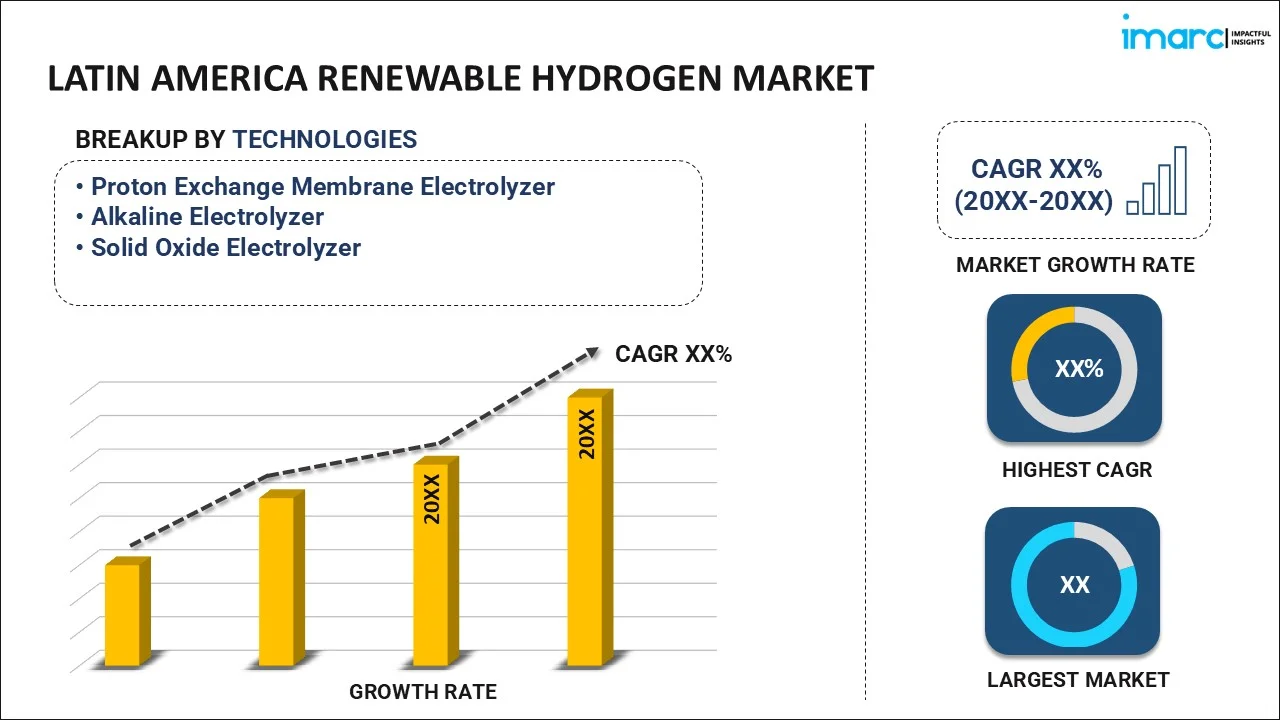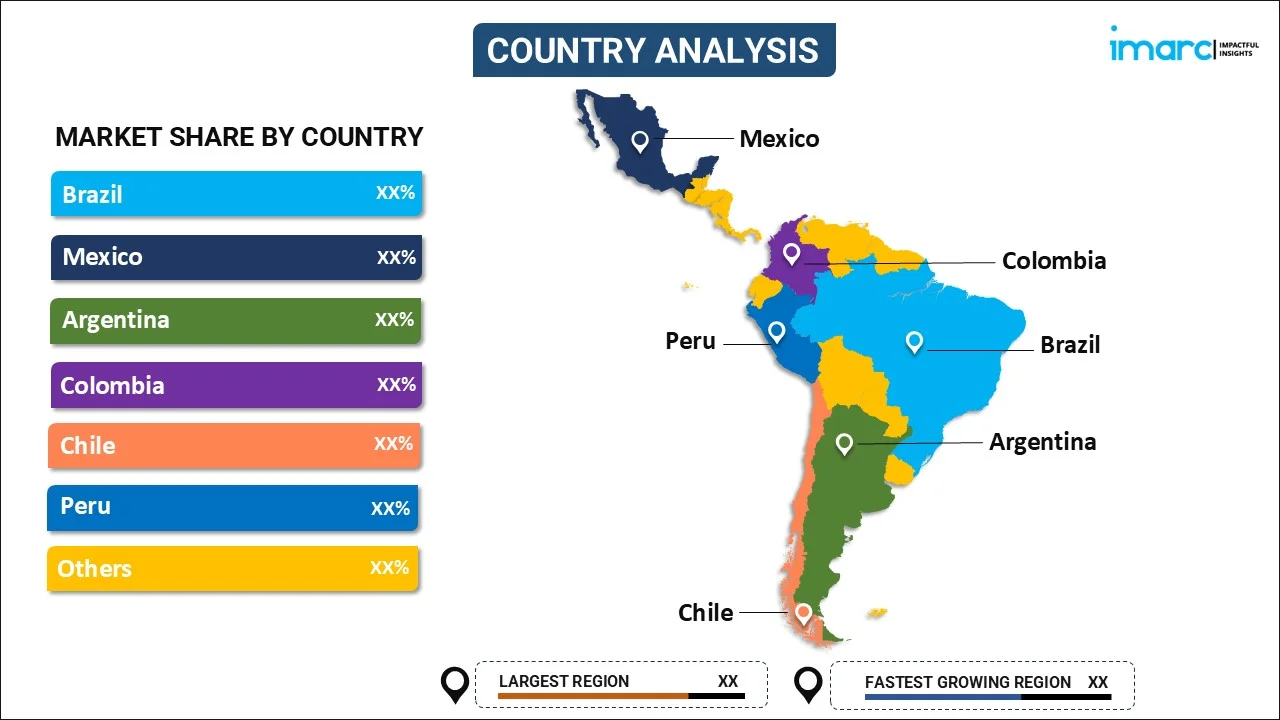
Latin America Renewable Hydrogen Market Size, Share, Trends and Forecast by Technology, Application, End Use Industry, and Country, 2025-2033
Latin America Renewable Hydrogen Market Overview:
The Latin America renewable hydrogen market size reached USD 92.73 Million in 2024. Looking forward, IMARC Group expects the market to reach USD 7,165.76 Million by 2033, exhibiting a growth rate (CAGR) of 57.50% during 2025-2033. The Latin America renewable hydrogen market has been driven by abundant renewable energy resources, proactive governmental policies, increasing international investments, and growing industrial demand for clean energy, with countries like Chile, Brazil, and Colombia leading initiatives to expand electrolyzer capacity, reduce hydrogen production costs, and strengthen global trade partnerships.
|
Report Attribute
|
Key Statistics
|
|---|---|
|
Base Year
|
2024 |
|
Forecast Years
|
2025-2033
|
|
Historical Years
|
2019-2024
|
| Market Size in 2024 | USD 92.73 Million |
| Market Forecast in 2033 | USD 7,165.76 Million |
| Market Growth Rate (2025-2033) | 57.50% |
Latin America Renewable Hydrogen Market Trends:
Abundant Renewable Energy Resources
Latin America possesses a highly varied array of renewable energy sources, positioning it as a potential future frontrunner in the global renewable hydrogen market. The diverse geography of Latin America offers significant opportunities for producing hydroelectric, wind, and solar energy. Additionally, approximately 60% of the electricity in Latin America is derived from renewable energy sources, emphasizing the region's capacity to generate clean energy. Countries like Chile and Brazil are exemplary in this regard. Chile's Atacama Desert has among the highest levels of solar irradiance in the world, with conditions well-suited for mass solar energy facilities. Likewise, Brazil's massive coastline provides valuable prospects for the utilization of wind power. Due to the presence of these renewable sources, low-carbon hydrogen is produced using a water electrolysis process with renewable power, often referred to simply as green hydrogen. The International Energy Agency emphasizes that Latin America and the Caribbean are likely to use natural and renewable energy resources to produce low-emission hydrogen and its products. The region’s significantly decarbonized electricity supply is further proof of this, as 60% of electricity there comes from renewable sources.
Proactive Governmental Policies
National governments in Latin America are proactively pursuing policies to encourage the development of the renewable hydrogen industry, seeing its capability to spur economic growth and environmental sustainability. The policies include national hydrogen strategies, legal changes, and fiscal incentives to encourage investment and infrastructure development. For example, Colombia has made important legal reforms to promote investment in hydrogen technology. The law of Law 2099 of 2021 is a testament to this vision, with the goal of setting up 1 GW of green hydrogen production and 50,000 tons of blue hydrogen yearly. Colombia's national hydrogen strategy has also set aside 2.5 billion USD to fuel the growth of the sector. These forward-looking government policies play a crucial role in establishing an enabling environment for the renewable hydrogen sector. Through offering transparent regulatory guidelines and funding, Latin American nations are drawing both local and foreign investments, thus speeding up the establishment of a sustainable hydrogen economy. Moreover, the complementarity between Latin America's rich renewable energy resources and the adoption of enabling governmental policies is propelling the region into an increasingly important position in the world renewable hydrogen market.
Latin America Renewable Hydrogen Market Segmentation:
IMARC Group provides an analysis of the key trends in each segment of the market, along with forecasts at the region/country level for 2025-2033. Our report has categorized the market based on technology, application, and end use industry.
Technology Insights:

- Proton Exchange Membrane Electrolyzer
- Alkaline Electrolyzer
- Solid Oxide Electrolyzer
The report has provided a detailed breakup and analysis of the market based on technology. This includes proton exchange membrane electrolyzer, alkaline electrolyzer, and solid oxide electrolyzer.
Application Insights:
- Power Generation
- Transport
- Others
A detailed breakup and analysis of the market based on the application have also been provided in the report. This includes power generation, transport, and others.
End-User Industry Insights:
- Food and Beverages
- Medical
- Chemical
- Petrochemicals
- Glass
- Others
A detailed breakup and analysis of the market based on the end-user industry have also been provided in the report. This includes food and beverages, medical, chemical, petrochemicals, glass, and others.
Country Insights:

- Brazil
- Mexico
- Argentina
- Colombia
- Chile
- Peru
- Others
The report has also provided a comprehensive analysis of all the major regional markets, which include Brazil, Mexico, Argentina, Colombia, Chile, Peru, and others.
Competitive Landscape:
The market research report has also provided a comprehensive analysis of the competitive landscape. Competitive analysis such as market structure, key player positioning, top winning strategies, competitive dashboard, and company evaluation quadrant has been covered in the report. Also, detailed profiles of all major companies have been provided.
Latin America Renewable Hydrogen Market News:
- November 2024: In the Latin America renewable hydrogen market, Hydrogen Europe and H2 Chile signed a Memorandum of Understanding to strengthen industry cooperation on clean hydrogen deployment and trade.
- October 2024: Chile implemented a national green hydrogen strategy, targeting the production of up to 160 million tonnes of clean hydrogen each year by 2050. 0.8-1.1 USD per kilogram by the conclusion of the decade, contributing more to the renewable hydrogen market in Latin America.
Latin America Renewable Hydrogen Market Report Coverage:
| Report Features | Details |
|---|---|
| Base Year of the Analysis | 2024 |
| Historical Period | 2019-2024 |
| Forecast Period | 2025-2033 |
| Units | Million USD |
| Scope of the Report |
Exploration of Historical Trends and Market Outlook, Industry Catalysts and Challenges, Segment-Wise Historical and Future Market Assessment:
|
| Technologies Covered | Proton Exchange Membrane Electrolyzer, Alkaline Electrolyzer, Solid Oxide Electrolyzer |
| Applications Covered | Power Generation, Transport, Others |
| End-Use Industries Covered | Food and Beverages, Medical, Chemical, Petrochemicals, Glass, Others |
| Regions Covered | Brazil, Mexico, Argentina, Colombia, Chile, Peru, Others |
| Customization Scope | 10% Free Customization |
| Post-Sale Analyst Support | 10-12 Weeks |
| Delivery Format | PDF and Excel through Email (We can also provide the editable version of the report in PPT/Word format on special request) |
Key Questions Answered in This Report:
- How has the Latin America renewable hydrogen market performed so far and how will it perform in the coming years?
- What is the breakup of the Latin America renewable hydrogen market on the basis of technology?
- What is the breakup of the Latin America renewable hydrogen market on the basis of application?
- What is the breakup of the Latin America renewable hydrogen market on the basis of end use industry?
- What are the various stages in the value chain of the Latin America renewable hydrogen market?
- What are the key driving factors and challenges in the Latin America renewable hydrogen market?
- What is the structure of the Latin America renewable hydrogen market and who are the key players?
- What is the degree of competition in the Latin America renewable hydrogen market?
Key Benefits for Stakeholders:
- IMARC’s industry report offers a comprehensive quantitative analysis of various market segments, historical and current market trends, market forecasts, and dynamics of the Latin America renewable hydrogen market from 2019-2033.
- The research report provides the latest information on the market drivers, challenges, and opportunities in the Latin America renewable hydrogen market.
- Porter's five forces analysis assist stakeholders in assessing the impact of new entrants, competitive rivalry, supplier power, buyer power, and the threat of substitution. It helps stakeholders to analyze the level of competition within the Latin America renewable hydrogen industry and its attractiveness.
- Competitive landscape allows stakeholders to understand their competitive environment and provides an insight into the current positions of key players in the market.
Need more help?
- Speak to our experienced analysts for insights on the current market scenarios.
- Include additional segments and countries to customize the report as per your requirement.
- Gain an unparalleled competitive advantage in your domain by understanding how to utilize the report and positively impacting your operations and revenue.
- For further assistance, please connect with our analysts.
 Request Customization
Request Customization
 Speak to an Analyst
Speak to an Analyst
 Request Brochure
Request Brochure
 Inquire Before Buying
Inquire Before Buying




.webp)




.webp)












